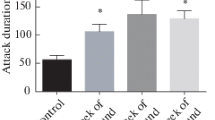Abstract
Crosby and Cahoon ( 1973) have proposed that the typical use of constant duration shock in shock-elicited social fighting between mature male rats may account for the general increase in fighting normally observed over sessions. In a test of their hypothesis, a variable duration shock group was compared with 2 constant duration shock groups. All groups demonstrated a significant increase in fighting over sessions. The results are discussed in reference to superstitious learning and alternative explanations of the “sessions effect” in shock-elicited fighting of rodents.
Similar content being viewed by others
References
AZRIN, N. H., RUBIN, H. B., & HUTCHINSON, R. R. 1968. Biting attacks by rats in response to aversive shock. Journal of the Experimental Analysis of Behavior, 11, 633–640.
AZRIN, N. H., ULRICH, R. E., HUTCHINSON, R. R., & NORMAN, D. G. 1964. Effect of shock duration on shock-induced fighting. Journal of the Experimental Analysis of Behavior, 7, 9–11.
BAISINGER, J., & ROBERTS, C. L. 1972. Reduction of intraspecies aggression in rats by positive reinforcement of incompatible behaviors. Journal of the Experimental Analysis of Behavior, 18, 535–540.
CAHOON, D. D., CROSBY, R. M., DUNN, S., HERRIN, M. S., HILL, C. C, & McGINNIS, M. 1971. The effect of food depriviation on shock-elicited aggression in rats. Psychonomic Science, 22, 43–44.
CONNER, R. L., & LEVINE, S. 1969. Hormonal influences on aggressive behaviour. In S. Garattini & E. B. Sigg (Eds.), Aggressive Behaviour. New York: Wiley. Pp. 150–163.
CROSBY, R. M., & CAHOON, D. D. 1973. Superstitious responding as an artifact in investigations of shock elicited aggression. The Psychological Record, 23, 191–196.
DENTI, A., & EPSTEIN, A. 1972. Sex differences in the acquisition of two kinds of avoidance behavior in rats. Physiology and Behavior, 8, 611–615.
DREYER, P. I., & CHURCH, R. 1968. Shock-induced fighting as a function of the intensity and duration of the aversive stimulus. Psychonomic Science, 10, 271–272.
DREYER, P. I., & CHURCH, R. M. 1970. Reinforcement of shock-induced fighting. Psychonomic Science. 18, 147–148.
EICHELMAN, B. S. 1971. Effects of subcortical lesions on shock-induced aggression. Journal of Comparative and Physiological Psychology, 74, 331–339.
HUTZELL, R. R., & KNUTSON, J. F. 1972. A comparison of shock-elicited fighting and shock-elicited biting in rats. Physiology and Behavior, 8, 477–480.
LATANÉ, B., FRIEDMAN, L., & THOMAS, J. 1972. Affiliation in rats under stress. Psychonomic Science, 27, 39–40.
MILLER, N. E. 1948. Theory and experiment relating psychoanalytic displacement to stimulus-response generalization. Journal of Abnormal and Social Psychology, 43, 155–178.
MILLIGAN, W. L., POWELL, D. A., & BORASIO, G. 1973. Sexual variables and shock-elicited aggression. Journal of Comparative and Physiological Psychology, 83, 441–450.
PAYNE, R., ANDERSON, D. C, & MURCURIO, J. 1970. Preshock-produced alternations in pain-elicited fighting. Journal of Comparative and Physiological Psychology, 71, 258–266.
POWELL, D. A., & CREER, T. L. 1969. Interaction of developmental and environmental variables in shock-elicited aggression. Journal of Comparative and Physiological Psychology, 69, 219–225.
ULRICH, R. E., & CRAINE, W. H. 1964. Behavior: Persistence of shock-induced aggression. Science, 143, 971–973.
ULRICH, R. E., HUTCHINSON, R. R., & AZRIN, N. H. 1965. Pain elicited aggression. The Psychological Record, 15, 111–126.
VERNON, W., & ULRICH, R. 1966. Classical conditioning of pain-elicited aggression. Science, 152, 668–669.
Author information
Authors and Affiliations
Additional information
Supported by NIMH Research Grant MH 21577-01.
Rights and permissions
About this article
Cite this article
Ghiselli, W.B., Thor, D.H. & Ward, T.B. A Social-Fighting Test of the Crosby-Cahoon Superstitious Responding Hypothesis in Shock-Elicited Aggression. Psychol Rec 24, 47–52 (1974). https://doi.org/10.1007/BF03394213
Published:
Issue Date:
DOI: https://doi.org/10.1007/BF03394213




